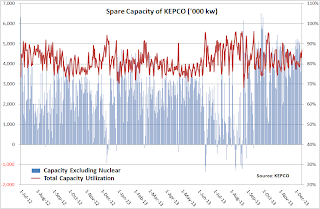A Japanese government panel recently advised to the central government to keep nuclear power as the nation's important and fundamental energy source. The government and utility firms could be actively to resume nuclear units. Currently all the nuclear units in Japan are shut.
However, since restarting requires further discussion and procedures, this winter will be the first time high electricity demand season without any nuclear power supply after the severe earthquake in 2011.
Especially, Kansai Electric Power Company will have the first experience to spend high demand season without nuclear units. Other electric companies have already survived previous winters and summers.
KEPCO forecasts that it could maintain more than 3% of spare generation capacity throughout this winter. But the daily maximum electricity demand in the company's service area had often exceeded its supply capacity excluding nuclear units in the previous few demand seasons. Therefore, the company will have to request to clients more reduction of electricity use.
Monthly electricity consumption in Japan has a tendency to decrease on year after the 2011 earthquake. Although the limit to the electricity supply has been expected to weigh on the country's economic growth, Japan's economic indicators have actually shown steady increase despite the lower electricity consumption.
Nuclear units are still necessary in order to maintain the nuclear technology development and keep an option of energy sources. However, its importance in Japan seems to have declined from the previous position.
On the other hand, Japanese power companies have increased use of liquefied natural gas for thermal power to make up for the shortage of nuclear power supply. Their monthly LNG consumption has risen to 4-5 million tonnes from the pre-earthquake level of 3-4 million tonnes. Beside the power firms' use, increasing fresh demands like co-generation have lifted Japan's monthly LNG imports by more than 1.5 million tonnes after the quake.
Meanwhile, North America is predicted to have about 20 million tonnes per month of LNG exporting capacity by the early 2020s due to the shale revolution. Many natural gas liquefy and export projects in the United States are being granted approvals.
Japan is expected to be a giant customer for the massive increase of LNG supply capacity. The U.S. energy industry might not hope that the Japanese natural gas demand will be hampered by nuclear power.




No comments:
Post a Comment